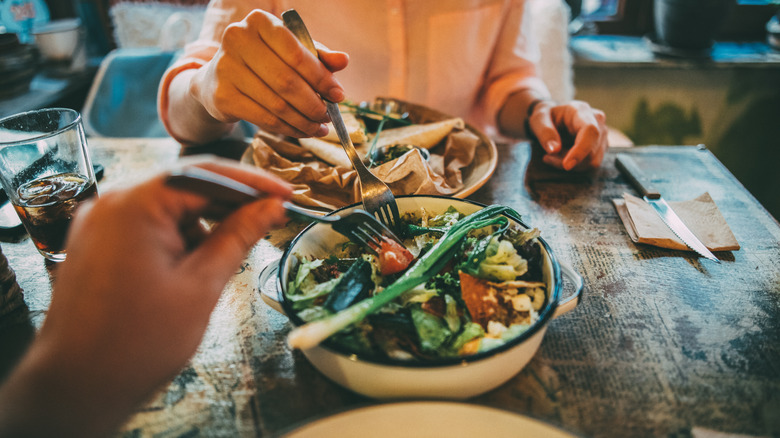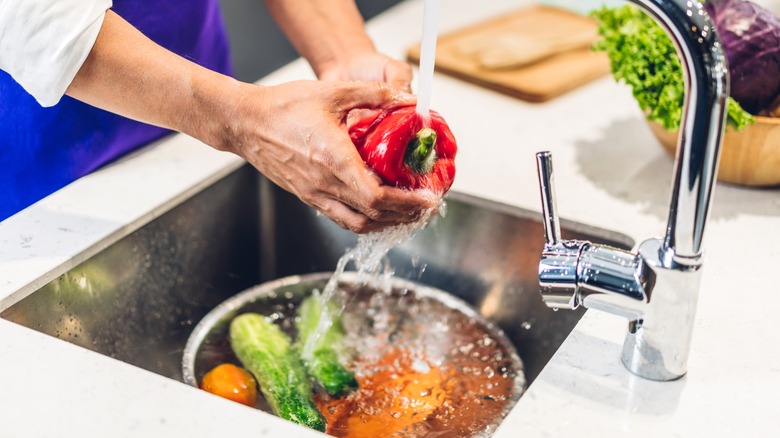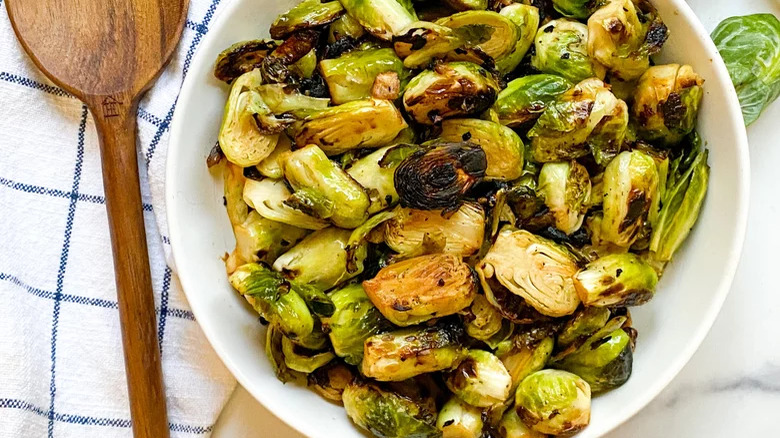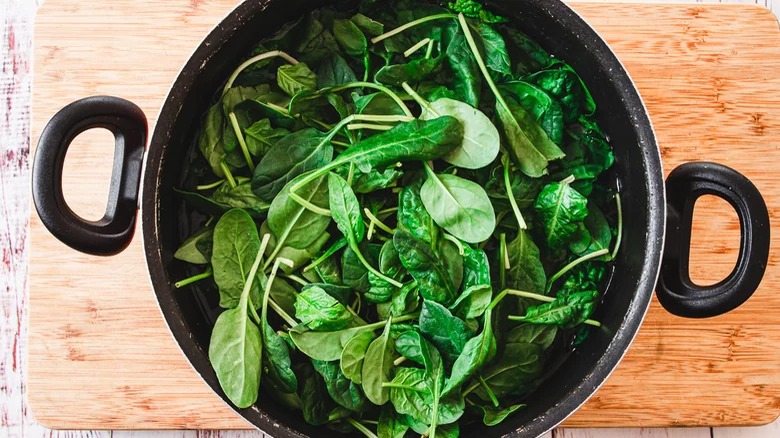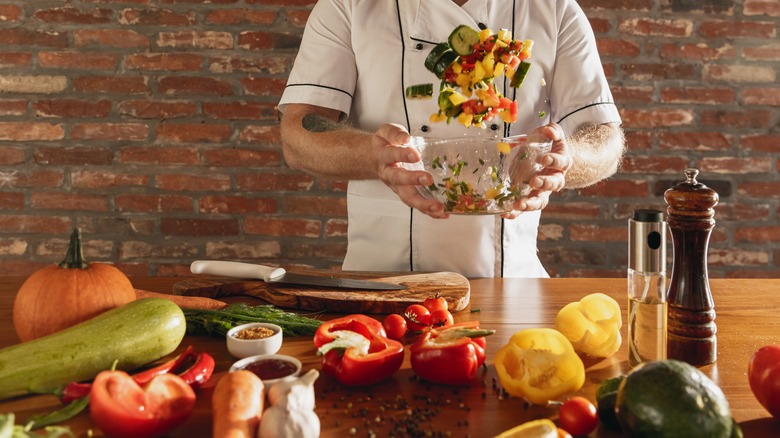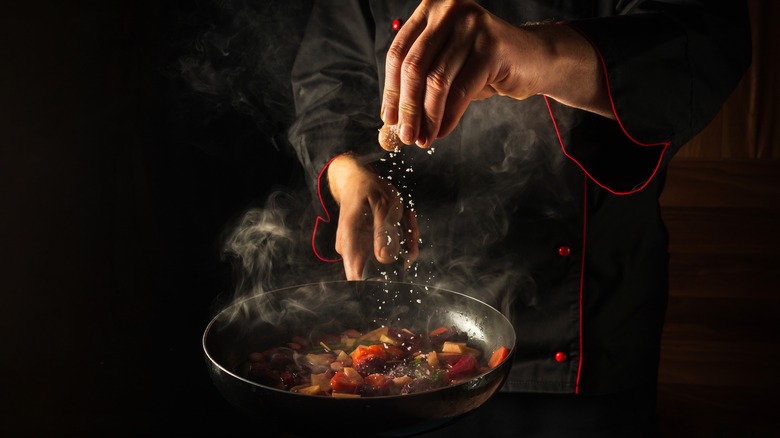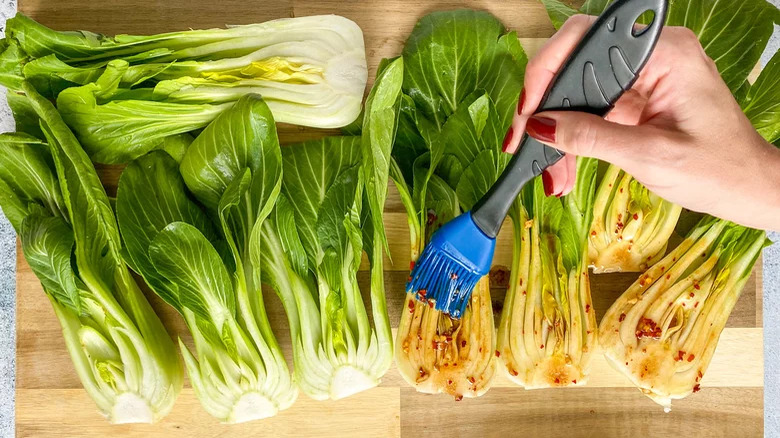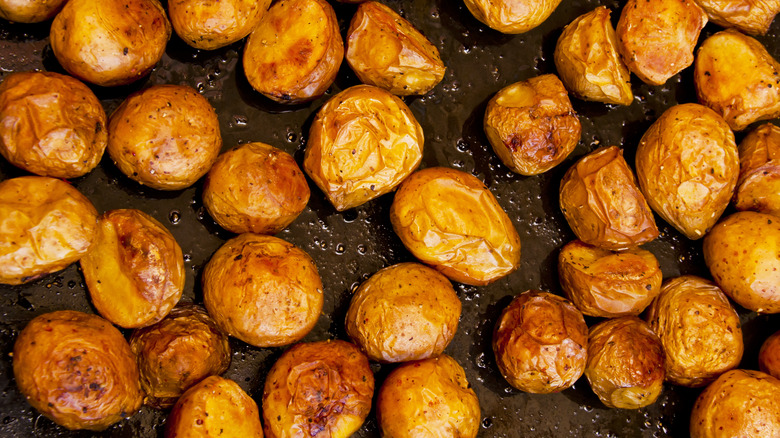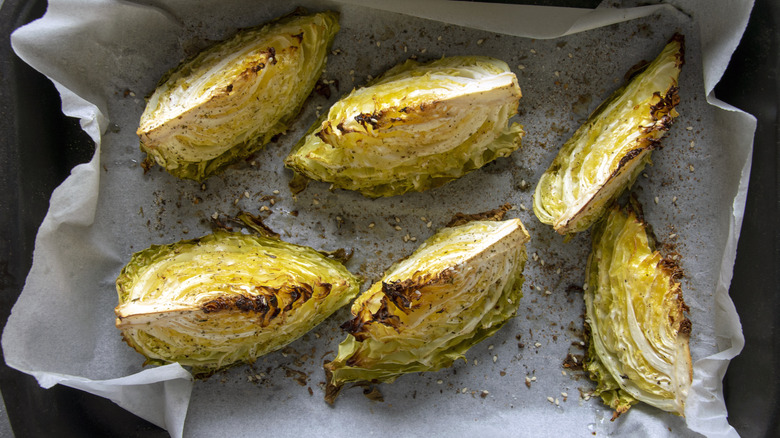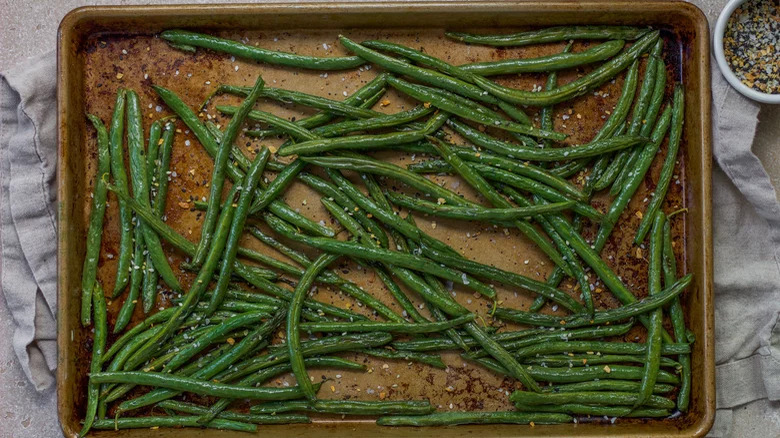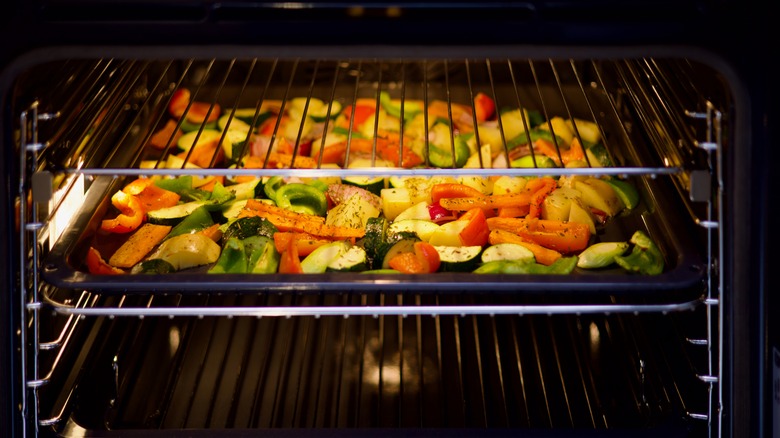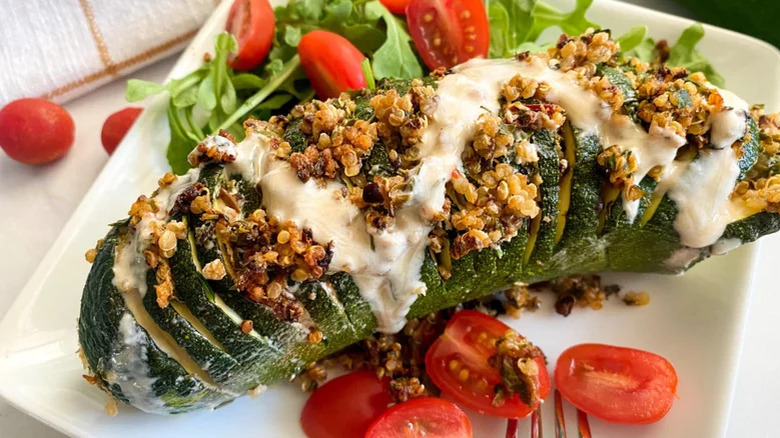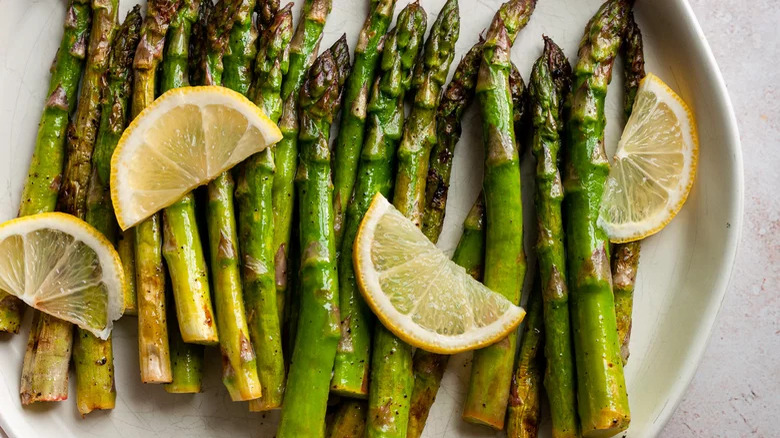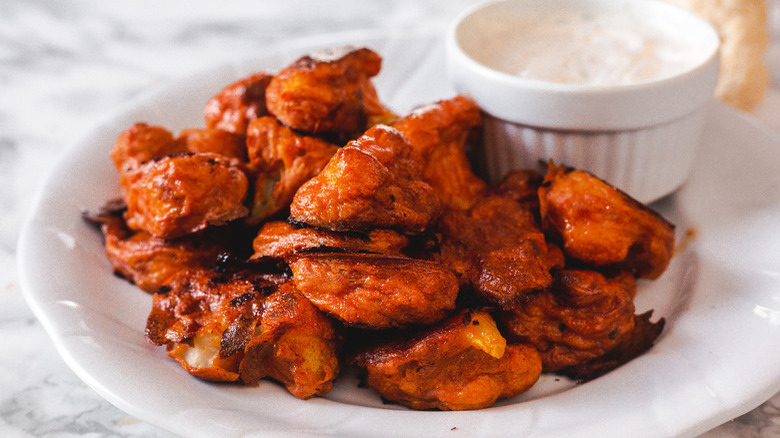Why Vegetables Always Taste Better At A Restaurant
When you were a kid, did you push veggies around your plate hoping they would magically disappear? Or did you hold back from digging into bowls of vegetables served during family dinners? The odor of boiling cauliflower and the taste of limp, watery green beans are enough to put anyone off. And in plenty of homes across the country, vegetable sides have often been relegated to must-have dishes rather than ones you relish and enjoy. What happened? How come as an adult you can't get enough of those scrummy veggies when you eat out? In fact, you might love vegetable dishes so much that you're inspired to try to recreate these sides at home. Give these copycat Texas Roadhouse green beans a go with crunchy bits of bacon. Or dig into a creamy Chick-fil-A copycat coleslaw recipe.
There are so many reasons why vegetables always taste better at a restaurant. At every step of the culinary journey, restaurant chefs are using techniques and tricks of the trade. When you taste an extraordinary veggie dish while eating out, it can transform the dining experience. How vegetables are regarded by chefs, and by diners, is so much more than it once was. Let's find out how they do it.
Restaurants use good-quality vegetables
When you go grocery shopping, you may pick up whatever veggies are available. Supermarkets often have discounts on goods that need to be used up soon. Of course, you may seek out local produce at a farmers market or some organic vegetables at an upscale store. You can make a simple vegetable stir fry with bell peppers, carrots, broccoli, and snow peas, and adapt the recipe to suit whatever ingredients you have on hand. Restaurants with a set menu have to make sure they source specific veggies, and because chefs order in larger quantities, they can find good-value, good-quality vegetables.
If you know what you're doing in the kitchen, then you can disguise some under-par cauliflower by making an Instant Pot mash. However, highly reviewed restaurants can't afford to serve diners anything but the best if pro chefs want the veggie dishes on the menu to shine. They know what to look for when it comes to freshness. Greens need to have robust stalks and leaves that are intact. Potatoes and onions should feel firm and not soft in places, while carrot roots shouldn't look wilted, and the vegetable should not feel bendy. Yellowing on broccoli is a no-no, and lackluster lettuce is a letdown that a good chef won't use.
A lot more oil is used to flavor vegetables
When you serve vegetable sides at the table for a family meal, you might add some pats of butter and a little seasoning. Butter melting on top of green beans gives the color a shine that's super appetizing. And hopefully, they've got just the right amount of crunch. You might drizzle an oil dressing on salad too. However, one reason that vegetables always taste better at a restaurant is that chefs there don't hold back on using oil to boost flavor. They often use oodles of butter, oil, or bacon fat to coat veggies fried on the stove and give them an umami appeal.
Love crispy Brussels sprouts in a restaurant? Wondering how they do it? There's a good chance that they've been deep-fried after being parboiled to get those crispy, tasty brown leaves. Try a less oily, but just as delicious version yourself. Grab a bottle of olive oil, and add a good glug to a cast-iron skillet. You need a couple of tablespoons to fry onion and garlic, before adding 32 ounces of vegetables to make panfried Brussels sprouts.
Greens are blanched
Ever wondered why restaurant greens always look so much more vibrant than when you serve boiled or even fried veggies at home? If you're out enjoying a meal at a Chinese restaurant, for example, the cabbage with oyster sauce just glistens and shines brightly with crunchy stems. Baby broccoli that's been charred on a griddle still looks fresh with a strong color that hasn't dulled. How do restaurants do that? They use a simple, yet effective cooking technique: blanching.
Greens are added to boiling water for a super-short time, such as a minute or two, and then plunged into iced water. The cold shocks the veg and stops the cooking process. What this does is it tenderizes the vegetables and makes them look brighter without having them wilt or soften too much. If you blanch Brussels sprouts, then they don't need as much time frying before they are ready. And less frying time means they are less likely to come out burnt-looking. Try wilting spinach in boiling water for 30 seconds followed by cooling it in icy water. When the veg isn't too hot to hold, squeeze out the liquid and pan-fry. With a heavy cream and nutmeg sauce, a grating of Parmesan cheese, and a sprinkling of chili flakes, you'll soon have a delicious creamed spinach dish.
Restaurants creatively combine salad veggies
You can't go wrong with a crisp green side salad or a classic Cobb salad entrée. There's something about the way that restaurant chefs present these dishes that always looks so appetizing. Sometimes, it's the little things such as a spectacular dressing or a gorgeous serving bowl that add that je ne sais quoi. And an al fresco dining terrace can create the perfect setting for munching on a healthy salad. But these aren't the only ways that chefs rustle up scrumptious salads. They creatively combine salad veggies for color, texture, and taste.
Forget throwing together a few limp lettuce leaves and some sliced tomatoes. Think about which ingredients are crispy and what adds a creamy, soft texture, as well as which veggies taste peppery and which are sweet. Tossing salads in a big bowl with a homemade dressing finishes them off in restaurant style. Looking for inspiration? What about making a shaved fennel salad with its citrusy tang and Asian-style sriracha, soy, and sesame oil dressing? In addition to the aniseed-tasting vegetable, you mix in romaine lettuce, fresh mint, and avocado along with grapefruit and orange.
A lot more salt is used to season vegetables
Professional chefs take seasoning seriously, and that's why vegetables always taste better at a restaurant. They know that no matter how great a vegetable tastes, adding salt substantially emphasizes the savory flavor. Spices may flavor a vegetable, but it's salt that's the daddy of the vegetable seasoning world. It's added to roast vegetables, included in water when boiling veggies, and sprinkled on a side before serving. It's not about creating a salty dish, but rather enhancing flavors. Have you ever tried mashed potatoes without any salt? Salt can take the bitterness out of broccoli, making it more like how you want this vegetable to taste.
Do you grind salt into a homemade dressing, such as a balsamic vinaigrette? The tangy, salty taste is so good doused over a salad. Some restaurant chefs actually salt the salad ingredients as well. If you feel this is too much, then you can always balance it out with a less salty dressing and more direct seasoning on the lettuce leaves. Soy sauce, fish sauce, and MSG are all used at various times in place of salt as they lend the same umami-boosting quality to vegetables. Restaurant kitchens often stock more than one type of salt too, such as kosher salt (which is best for cooking with), a table salt, and a fine and flaky salt.
Restaurants add tasty seasonings to veggies
Salt makes vegetables taste better, while other seasonings add different flavors. Here's where skilled restaurant chefs can show their understanding of ingredient pairings. For example, cumin complements carrots, chili flakes bring out the best in leafy greens, and mushrooms are incredible with herbs like tarragon and rosemary. There are no fixed rules, though, so innovative chefs wow diners with new ways of seasoning veggies all of the time. As well as adding flavor, spices create wonderful aromas and can evoke the taste of certain types of cuisine, from Mediterranean to Asian. Sumac and za'atar give Middle-Eastern-style vegetable dishes a lemony lift. Tough herbs, like rosemary, are perfect for adding when you roast vegetables. Less robust types, like basil, are often added as a final flourish. Spices work well when combined with fat and are cooked through.
A great recipe to see just how spices can change up the flavor of vegetables is grilled bok choy. Add red pepper flakes, minced garlic, and soy sauce to sesame oil and brush on the vegetable once it's been halved lengthways. The contrast of a spicy, slightly sweet, salty flavor with the charred leaves transforms this Asian vegetable. You can turn veggies into savory snacks too. For these cheesy kale chips, add steak spice, salt, and cheesy-tasting nutritional yeast to extra virgin olive oil and cover the chopped kale with it. A final blast in the oven with some Parmesan cheese increases the flavor and adds to it.
Vegetables are added to hot oil when roasted
Roasted veggies are incredible. When they are done well, which restaurant chefs should know how to do, they are the best. What you want is a soft and tender veggie that's sublimely sweet with the roasting bringing out the natural sugars. You also want the veg to look browned and even a little charred in places. A great serving of roast vegetables looks just as good as it tastes.
Rather than adding the vegetables to a roasting tray with oil, you could heat the tray and oil first. As soon as you add any veggies, they are going to sizzle and brown immediately. That means they are starting to caramelize, and any cook knows this is where the flavor starts to kick in. Try our version of Jamie Oliver's roast potato recipe, which guides you to use cold goose fat or duck fat and olive oil. See if it makes a difference if you heat the fat and oil first. What's great about this dish is that after an hour of roasting, you toss the hot new potatoes in olive oil and fresh oregano before roasting some more.
Bigger ovens means more space
If you've got a double oven or just a big oven, then you'll know just how much easier it is to cook several dishes. Need to pop a joint of beef in to roast along with some Yorkshire puddings and some roasted cabbage? No problem. While bad chefs can't blame their equipment, there's a lot to be said about the difference a large appliance makes. Commercial kitchens are designed to feed a restaurant full of diners. And even if the eatery is small, that's still potentially a lot of demand for quality veggies that come piping hot and delicious from the oven.
The key to fantastic roasted vegetables is space. This isn't just so that you can cram in a lot of veggies, but so that you can add them to a tray in a single layer. If the vegetables are too close together, they won't get that lovely brown crispness on the outside. Instead, the moisture from an overfull tray will start to steam the veggies rather than roast them. And let's face it. There's nothing worse than soggy, soft vegetables that are supposed to be crisp and roasted. Chefs can space vegetables out more easily, and you can too if you grab another tray.
Roasting lots more vegetables
Quality restaurant chefs are really great at going beyond serving up only classic roasted vegetables. Not that there's anything wrong with roasted sweet potatoes, onions, and bell peppers. But because they know it's such a taste-provoking way of cooking, they also know that way more veggies taste good when roasted. If you've ever tasted roasted cauliflower –- and it's beyond essential that you do if you haven't because it's unbelievably good -– then you'll know why this restaurant-style approach is such a winner.
Roasted broccolini is fantastic and so much more restaurant-esque than a few overcooked boiled florets. It's totally on another level. What about a roasted beet salad recipe linking the soft and sweet texture of hot beetroot pieces with walnuts, goat cheese, and mixed greens? And have you ever thought about serving roasted green beans, or are they usually pretty standard? Roasting vegetables that aren't usually cooked in this way improves the taste and delights the senses, giving veggies a restaurant-quality cook-over. Restaurant dishes with vegetables in them are often made with roasted veg to add some sweet smokiness. A roasted vegetable quiche with zucchini, bell peppers, cherry tomatoes, and red onion is going to be a step up flavor-wise, for example.
Roasted vegetables are cooked at a high temperature
With multiple ovens, chefs have the space and time to roast vegetables in a way that brings out the terrific taste. They also often have a better grasp than the average home cook of what temperatures to use. A chef-style tip for making the most of roasting is to make sure that the oven is set at a high enough temperature. Preheat it to around 450-475 degrees Fahrenheit on the convection setting to let the hot air swirl around your tray of veggies. You'll end up with a crispier roast veg just as you might in a great bistro.
Not all expert advice is the same, nor is every vegetable or recipe. You can also successfully roast vegetables that are not too full of moisture at home at 335 degrees Fahrenheit. For juicier vegetables, a higher temperature is better. To make the most out of the heat, toss the tray full of veg once in a while for a more even browning. Chefs know how to add visual interest by cutting various types of veg in different ways, and they also have the experience to have learned how long each type needs roasting. If the oven is set high, then a whole celeriac might take longer than a parboiled potato or a soft half-moon of zucchini. And all chefs know that roasting veg reduces the size, so in addition to turning the oven up, you may need to increase the portion size.
Restaurants serve more creative vegetable sides
When cooking at home, it's commonplace to focus on the protein on a plate and pay less attention to the veggies. But an innovative chef regards a vegetable side as an opportunity to make a culinary impression on diners. Restaurants tend to serve more creative vegetable sides, and that's why they look and taste better. You're less likely to make a creamy miso zucchini on a Monday night, but this chef-inspired creation from TikToker @robhomecook is perfect for a dinner party or when you want to impress. The reality is that it's easy to do and involves mixing white miso paste with cream and spooning it over the pan-fried vegetable. Often all that's lacking among home cooks is some imagination.
Embrace a sense of theatre if you want your veggies to taste as good as those on a delicious restaurant menu. One vibrant-looking dish is hasselback zucchini. After cutting into the zucchini to create a concertina effect, stuff each slit with a mixture of quinoa, sun-dried tomatoes, olives, and capers, with some garlic, lemon zest, parsley, and nutritional yeast in there too. After baking it, top with a creamy tahini sauce. This works so well as a sharing appetizer or a plant-based entrée. Heck, you could even open your own restaurant with this one!
The flavor of vegetables is enhanced after cooking
A restaurant chef might make air fryer cauliflower with curry seasoning, sauté some mushrooms, or roast some vegetables. However, when it's time to serve up a veggie side, appetizer, or entrée, there's another opportunity to enhance the flavor. One of the best ways to bring out even more taste and give a dish a fresh flavor is by giving it a quick citrus spritz.
Grilled asparagus is one of those dishes that feels special. When it's cooked on a griddle pan or grill, it also looks good enough to eat too. It's also fabulous baked in the oven. However, without any after-cooking flavor-bombing, it won't taste like a restaurant dish. Think lemon juice and zest, minced garlic, and a fine-grated dust of Parmesan cheese. Make lemony grilled asparagus, and add the tangy flavors during and after cooking. Toss the spears in olive oil, lemon juice, salt, and black pepper before sizzling on the grill. Build on those ingredients by serving with lemon slices for extra zing. Parmesan cheese is wonderfully salty, chili flakes evoke some heat, and truffle oil and sesame oil are umami superstars. Parsley and cilantro sprinkled on Southern-style fried squash bring freshness to fried, panko-encrusted veggies.
Restaurant vegetables are sometimes served with a sauce or dip
Most people are not against grabbing a dip with some chips, but restaurants add these flavor boosters to vegetables too. Veggie snacks are so much more appetizing to diners with some sriracha mayo on the side, for example. Dips made out of veggies, such as guac, can become a centerpiece. Some dips are packed with flavor-bursting ingredients such as our copycat Chuy's creamy jalapeño dip recipe made with pickled jalapeños, cilantro, and ranch dressing mix, plus lime juice and garlic powder.
Some veggie dishes need a dip to feel complete, just like a salad needs a dressing. Grilled sweet potato wedges are crispy and charred on the outside and soft inside. And they are undeniably made for dipping. Anything goes, such as ranch, chipotle mayo, or a homemade blue cheese dip. Chefs know how to make dips and veggies pair up too. Nothing complements sticky and sweet, batter-coated Buffalo cauliflower like ranch. Another trick up the sleeve of their chef whites is to improve veggies with a sauce. Try it for yourself by making copycat Red Lobster Brussels sprouts. There's no way those air-fryer vegetables would be as moreish without a garlic, ginger, soy sauce, and brown sugar mixture poured over the top. And don't forget the garnish, which in this case is a few crispy fried onions.
